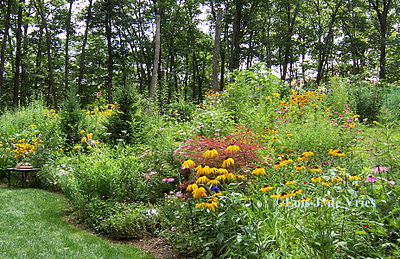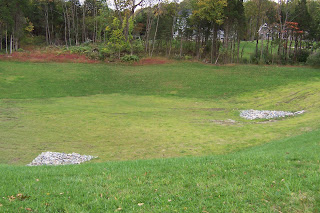7 Secrets to Creating The Garden of Your Dreams Secret #7: Know Where To Start
 |
| This septic system's mounded leach field is planted as a perennial garden. |
Working on the garden landscape is such an exciting pastime that it’s hard not to jump right in with every next big idea that comes along. In some ways, the garden industry is not very different from the fashion industry – styles come and go; this year’s “in” color is “out” next year; breeders are constantly tweaking petal profile, plant height, color, and shape; and trends, such as replacing the front lawn with meadow grasses, installing a Koi pond, or building a private water park, come and go.
Permits and professionals
If you’re planning to make some big or important changes, do you know where to start? Practical matters come first. If you envision any major structural or drainage modifications, check with your local governing authority about what permits may be required and whether certain types of work must be done by an engineer or other professional. You don’t want to pay a contractor big bucks to install a boulder wall, only to find that he’s built it in the town’s right of way, on the wrong side of your property line, or in a drainage easement. (Yes, these things really do happen.)
Environmental considerations
Stormwater management and other environmental regulations are evolving. Practices that were once considered harmless, such as draining a wetland or damming up a stream, are now prohibited in many towns and carry the added clout of state statutes. Run afoul of these laws and you’ll pay a heavy price in fines or remediation. (Yes, people have been made to remove a swimming pool constructed in a conservation easement.)
Make one call
Check for underground utilities. Many states employ a “one-call” system that enables you, your designer, or excavator to alert power, water, cable, gas, and telephone companies where you’re planning to dig. The utilities will come out to your site and mark the location of their services at no charge, but you need to plan ahead, because the utility may require up to 10 days notice to send a worker out.
If you live in an area that doesn’t have city-operated water and sewer, find out where your septic system and leach field or sewer pipes are and don’t build or plant anything important there.
Think twice
When you’re caught up in the excitement of a landscape redesign, it’s easy to downplay the costs of these accessory factors. Be flexible. Consider carefully whether it makes sense to proceed with your original plan in light of the total expense. You may find it’s more practical to tweak or scale down the project to avoid some of them.
For more on this topic, go to http://cultivatingtheinnergardener.blogspot.com
Permits and professionals
If you’re planning to make some big or important changes, do you know where to start? Practical matters come first. If you envision any major structural or drainage modifications, check with your local governing authority about what permits may be required and whether certain types of work must be done by an engineer or other professional. You don’t want to pay a contractor big bucks to install a boulder wall, only to find that he’s built it in the town’s right of way, on the wrong side of your property line, or in a drainage easement. (Yes, these things really do happen.)
Environmental considerations
Stormwater management and other environmental regulations are evolving. Practices that were once considered harmless, such as draining a wetland or damming up a stream, are now prohibited in many towns and carry the added clout of state statutes. Run afoul of these laws and you’ll pay a heavy price in fines or remediation. (Yes, people have been made to remove a swimming pool constructed in a conservation easement.)
Make one call
Check for underground utilities. Many states employ a “one-call” system that enables you, your designer, or excavator to alert power, water, cable, gas, and telephone companies where you’re planning to dig. The utilities will come out to your site and mark the location of their services at no charge, but you need to plan ahead, because the utility may require up to 10 days notice to send a worker out.
If you live in an area that doesn’t have city-operated water and sewer, find out where your septic system and leach field or sewer pipes are and don’t build or plant anything important there.
Think twice
When you’re caught up in the excitement of a landscape redesign, it’s easy to downplay the costs of these accessory factors. Be flexible. Consider carefully whether it makes sense to proceed with your original plan in light of the total expense. You may find it’s more practical to tweak or scale down the project to avoid some of them.
For more on this topic, go to http://cultivatingtheinnergardener.blogspot.com

